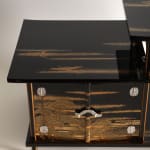Maki-e Lacquer artist
Set of Shelves with Designs Based on the Noh Drama Takasago, 1910s-1920s
Maki-e gold lacquer on wood with gold foil inlays and silver hardware
Size 14 x 26¼ x 13 in. (35.7 x 66.5 x 32.7 cm)
T-4987
Further images
-
(View a larger image of thumbnail 1
)

-
(View a larger image of thumbnail 2
)

-
(View a larger image of thumbnail 3
)

-
(View a larger image of thumbnail 4
)

-
(View a larger image of thumbnail 5
)

-
(View a larger image of thumbnail 6
)

-
(View a larger image of thumbnail 7
)

-
(View a larger image of thumbnail 8
)

-
(View a larger image of thumbnail 9
)

-
(View a larger image of thumbnail 10
)

-
(View a larger image of thumbnail 11
)

-
(View a larger image of thumbnail 12
)

-
(View a larger image of thumbnail 13
)

-
(View a larger image of thumbnail 14
)

-
(View a larger image of thumbnail 15
)

-
(View a larger image of thumbnail 16
)

A set of shelves comprising a base supported on four splayed feet, a cupboard with hinged doors to the left and a taller shelf to the right, the entire surface...
A set of shelves comprising a base supported on four splayed feet, a cupboard with hinged doors to the left and a taller shelf to the right, the entire surface covered in polished roiro black lacquer and decorated in gold, silver, and colored hiramaki-e and takamaki-e with rich embellishments of gold hirame flakes and kinpaku foil, the cupboard’s hinges and catches, as well as curved edges of solid silver, the decoration comprising an auspicious composition of cranes, pines, clouds, and waves, the doors inscribed on the reverse in gold maki-e respectively 'shikai nami' and 'shizuka ni'. Comes with a black-lacquered storage box.
This meticulously decorated lacquer cabinet, dating from the early decades of the twentieth century, is a small-scale variation on the classical chigaidana, an asymmetrical set of shelves that was among the principal components of an elaborate, extravagant set of lacquer furniture and utensils customarily presented to elite brides during the Edo period (1615-1868). Made by a leading Kyoto lacquer workshop such as the Zōhiko Company, it was likely commissioned by a member of one of Japan’s newly emergent wealthy industrial dynasties and would have been intended as an elite, high-status wedding gift.
The decoration, along with the five characters written on the backs of the doors, represents Takasago, the location for the Noh drama of the same name, one of the masterpieces of the medieval playwright Zeami (1363-1443). Takasago tells the story of a Shinto priest's encounter with the spirits of two ancient trees, one at Takasago in Harima Province and the other in Settsu Province. The spirits reveal that they are husband and wife: although they are separated by a great distance, their hearts are forever united. This example of long-distance conjugal fidelity would have been especially appropriate at a period when, for the first time in Japanese history, elite married couples might be separated by thousands of miles for months or years due to business, military, or diplomatic commitments.
The phrase shikai nami shizuka ni comes early in the text of Takasago, at the end of a dialogue between the old couple, Jō and Uba, and Tomonari, a Shinto priest who visits their home on Takasago Bay in Harima Province. Closing the scene, the chorus intone “The four oceans are silent. This is an age of universal peace, when thanks to the glorious reign of our emperor we may live in harmony, just like the celebrated Paired Pines.”
This meticulously decorated lacquer cabinet, dating from the early decades of the twentieth century, is a small-scale variation on the classical chigaidana, an asymmetrical set of shelves that was among the principal components of an elaborate, extravagant set of lacquer furniture and utensils customarily presented to elite brides during the Edo period (1615-1868). Made by a leading Kyoto lacquer workshop such as the Zōhiko Company, it was likely commissioned by a member of one of Japan’s newly emergent wealthy industrial dynasties and would have been intended as an elite, high-status wedding gift.
The decoration, along with the five characters written on the backs of the doors, represents Takasago, the location for the Noh drama of the same name, one of the masterpieces of the medieval playwright Zeami (1363-1443). Takasago tells the story of a Shinto priest's encounter with the spirits of two ancient trees, one at Takasago in Harima Province and the other in Settsu Province. The spirits reveal that they are husband and wife: although they are separated by a great distance, their hearts are forever united. This example of long-distance conjugal fidelity would have been especially appropriate at a period when, for the first time in Japanese history, elite married couples might be separated by thousands of miles for months or years due to business, military, or diplomatic commitments.
The phrase shikai nami shizuka ni comes early in the text of Takasago, at the end of a dialogue between the old couple, Jō and Uba, and Tomonari, a Shinto priest who visits their home on Takasago Bay in Harima Province. Closing the scene, the chorus intone “The four oceans are silent. This is an age of universal peace, when thanks to the glorious reign of our emperor we may live in harmony, just like the celebrated Paired Pines.”















